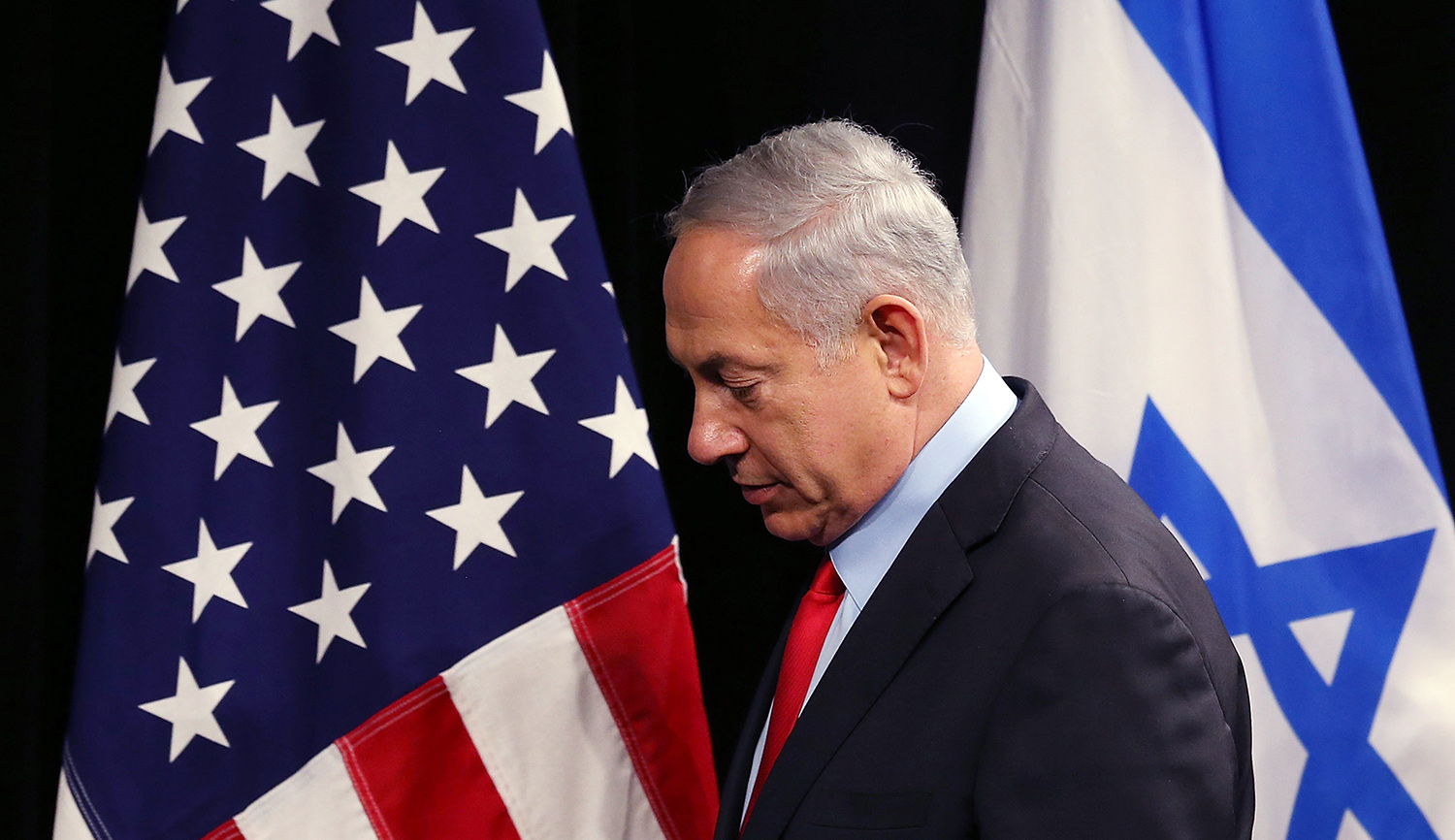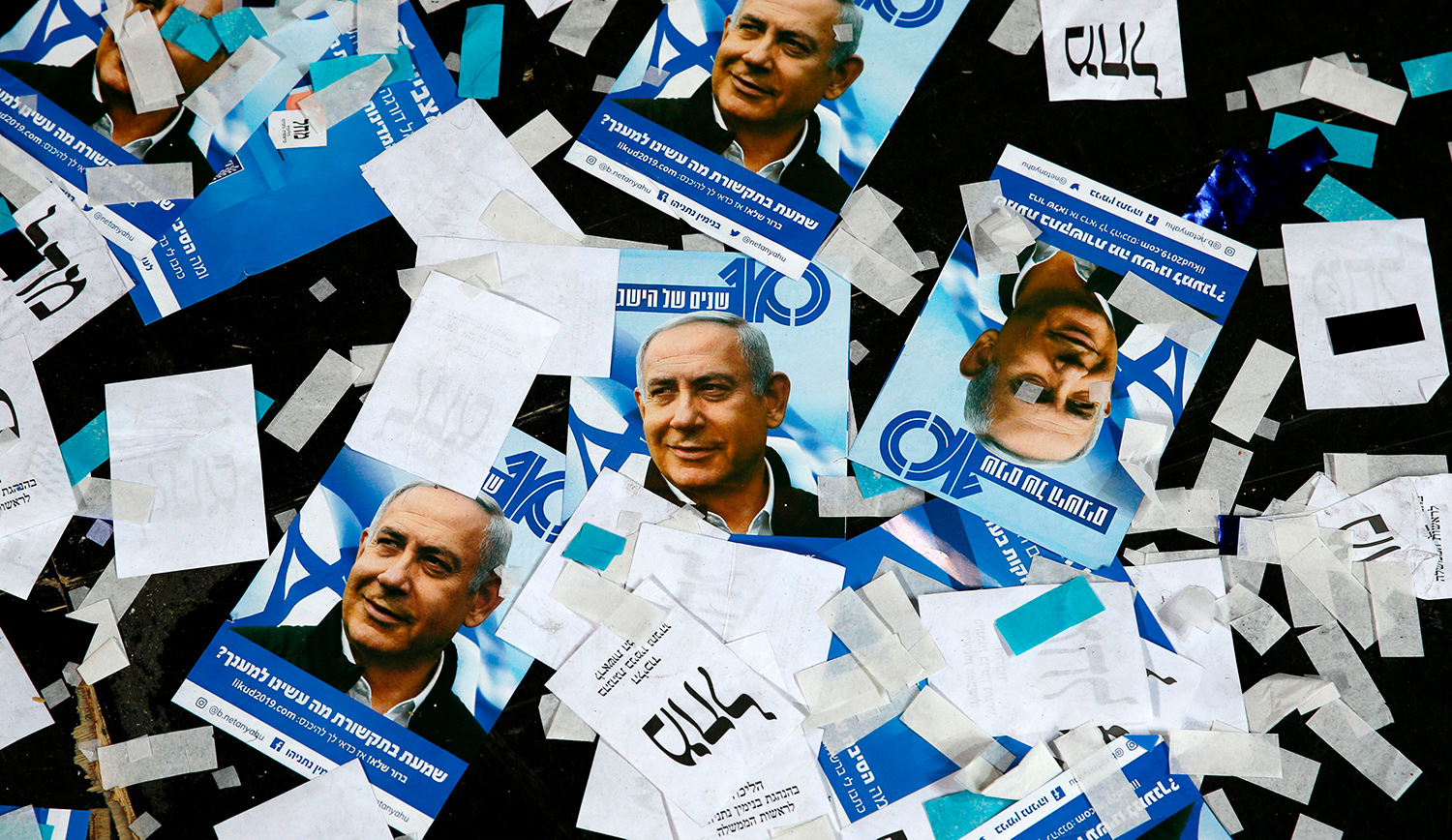Much of the foreign commentary after Israel’s April 9 election has dealt with its supposed effect on Israel-Palestinian relations. Because the results were good for incumbent Prime Minister Benjamin Netanyahu, critics say they are bad for “peace diplomacy.” As one Washington Post columnist complained, “Israel’s election has made the path to a two-state solution even rockier.”
To the average Israeli, these complaints are beyond stale, bringing to mind debates that raged mostly in the 1980s and 90s but today are nearly non-existent. What the election effectively confirms is that Israelis, by a huge majority, blame the lack of peace on the Palestinian Authority (PA), not on Netanyahu’s government. Although most remain willing to recognize Palestinian statehood, they’ve lost hope that this would satisfy their enemies or end the conflict.
As Haviv Rettig Gur puts it in his incisive Mosaic essay:
From the partisan division of the 1990s, the experience of the past two decades has pushed most Israelis to a new consensus. The essence of the consensus is that both sides were correct. Just as the left contended, extended Israeli control over the Palestinians is undesirable and untenable. Just as the right insisted, and as the intransigent irredentism of the Palestinians has shown, reconciliation is not in the cards.
This is why the conservative bloc—Netanyahu’ s Likud and the other parties now expected to form the next government—won 65 out of 120 parliamentary seats, while Likud’s main challenger, the new Blue and White party led by Benny Gantz, won an additional 35 seats by arguing that the country should rid itself of Netanyahu but retain his security policies. It also accounts for the remarkable fact that many young Israeli voters joined their elders in endorsing this consensus. According to a poll cited in the Wall Street Journal, “Likud won a plurality of eighteen-to-twenty-four-year-olds, with 27 percent, while the centrist Blue and White party received 21 percent.”
A quick jog through Israeli history will help explain how peace-processing evolved from a subject of hot controversy to a virtual non-issue.
In Israel, debates about peace became venomous only in 1977, after the voters elected their first non-Labor prime minister: Likud’s Menachem Begin. Stunned Labor leaders, whose party had dominated Jewish politics in the Holy Land since the Zionist movement’s infancy, promptly began to argue that Likud’s brand of nationalism, including talk of Jewish historical and religious claims to the whole Land of Israel, constituted the main impediment to peace. (This did not explain why peace had eluded the several Labor prime ministers in the decade since the Six-Day War . . . but no matter.)
Labor pressed its argument that Likud was the anti-peace party even after Begin, in March 1979, concluded a peace treaty with Egyptian president Anwar Sadat that required Israel to remove all of its civilians and military forces from the Sinai Peninsula. Indeed, Labor leaders then insisted with increased conviction that Israel could end the Arab-Israeli conflict altogether if it were willing to continue to trade “land for peace”—that is, relinquish more of the territory lost by the Arabs when they initiated the 1967 war.
Labor’s argument had appeal because it assured Israelis that they could control their own fate; they could have peace if they wanted it. By voting Likud out and restoring power to leaders ready to trade land, they could not only end the conflict, they could have “peace now”—a phrase that became the rallying cry of Israel’s self-designated “peace camp.”
When, starting in December 1987, the first intifada drove home the high costs of Israel’s control of the territories, the allure of “peace now” increased. That helped Labor’s Yitzḥak Rabin win the June 1992 elections on a platform promising a land-for-peace deal with the Palestinians within nine months.
In September 1993, Rabin signed the Oslo accords with PLO chief Yasir Arafat. That the deal was far less favorable than what he had promised may account for Rabin’s dyspeptic appearance as he shook Arafat’s hand on the White House lawn. Nevertheless, Rabin declared he was putting Israel on the best available path to peace, and most Israelis gave their support.
Oslo created the Palestinian Authority, headed by Arafat. As it grew in power, Palestinian terrorism not only continued but intensified, killing more Israelis in the five years after Oslo began than in the previous fifteen years. The resulting disillusionment in Israel helped Benjamin Netanyahu win election to his first term as prime minister in 1996. In its campaign, Likud made the case that the PA was untrustworthy, was headed by unreformed terrorists, and was violating Oslo with impunity.
As prime minister, however, Netanyahu did not abrogate Oslo, or take back civil authority that Israel had transferred to the Palestinians. In fact, he moved the process forward through a new agreement with Arafat.
Israel held elections again in 1999, and debates about peace once again dominated the campaign. Labor’s Ehud Barak, a former army chief of staff, defeated Netanyahu by promising to deliver both peace and security. His first radical move was to withdraw Israeli forces unilaterally from southern Lebanon; his second came a few weeks later when he met with Arafat and President Bill Clinton at Camp David and made a peace proposal more forthcoming on Palestinian statehood, territory, and other issues than anything any Israeli leader had ever suggested—including giving the Palestinians control of Jerusalem’s Temple Mount.
But Arafat, instead of accepting or asking for modifications, pressed an additional demand: that millions of Palestinians living outside Israel be granted a right to “return.” On that issue, the Camp David talks foundered.
Amos Oz, Israel’s eminent novelist, declared afterward: “my heart breaks.” As a founding father of the “peace camp,” Oz wrote that even though Barak had offered “the solution I foretold over 30 years ago,” the Palestinians had still refused, insisting on a right of return that, as “we all very well know, . . . is an Arab euphemism for the liquidation of Israel.” Seconding this cry of the heart was A.B. Yehoshua, another prominent Israeli writer and “peace camp” founder, who denounced Arafat and lamented that the “dream which we have been trying to realize since 1967—the establishment of a Palestinian state alongside Israel—amounts today to fiction.”
A few weeks after the meeting at Camp David, Arafat launched the second intifada, which continued for five years, killing over a thousand Israelis. PA security forces, which had been created to prevent terrorism, perpetrated many of the attacks.
Among the casualties was Barak’s premiership. He lost the 2001 elections to another former general, Likud’s Ariel Sharon—who, despite his skepticism about the peace process, also did not abrogate Oslo or destroy the PA. In fact, in 2005, Sharon unilaterally ended Israel’s occupation of Gaza, dismantling all Israeli settlements, forcibly removing the settlers, and withdrawing all Israeli military forces.
Unlike Rabin, Sharon did not pretend this was part of any land-for-peace deal. Instead, he believed that control of Gaza was both burdensome and no longer necessary for security reasons. He hoped—in vain, as it turned out—that Israel would be able to deter Palestinian attacks from Gaza.
Within two years, the Islamist terrorist group Hamas had seized control of Gaza from the PA, and the now-unoccupied territory became a base for anti-Israel attacks. These produced terror and anger in Israel, provoked reprisal, and further lowered expectations that territorial concessions would win Palestinian goodwill. But the attacks generated no support to speak of, even within Likud, for an Israeli reoccupation of Gaza.
The attacks did, however, redound to Netanyahu’s political credit, and the 2009 elections made him prime minister again. Since then, he has won three more elections, including the most recent one. His success, critics argue, shows that Israel has become more extreme—that is, less desirous of peace and less willing to make necessary concessions. But the polls paint no such picture. Most Israelis say they favor territorial concessions that would allow Palestinians to live independently of Israel in the West Bank and Gaza. The main thing that has eroded over the years is not a willingness to relinquish land but confidence among Israelis that peace can be had through negotiations with the PA, whose leadership achieved the seemingly impossible by extinguishing the optimism even of such ardent peace pursuers as Amos Oz.
In sum: Israel, through the Oslo process and in the name of peace, gave up control over much of the West Bank and Gaza by agreement. What followed was more terrorism, and then in the 2000s even more. Later, Israel unilaterally quit southern Lebanon and Gaza. Its reward has been a series of wars with Hizballah (in 2006) and Hamas (in 2008-09, 2012, and 2014). What further relinquishments should it try now?
The reality of the Israeli consensus highlighted by Haviv Gur is visible not only in the most recent election but in other developments, left and right.
That left-wing Israelis have lost faith in Oslo’s promise of peace is evident from what has become of Labor. The formerly all-powerful party now commands a pathetic six parliamentary seats.
That even Israeli right-wingers acknowledge the impracticality of permanent control of the West Bank is evident in the fact that in 2009 Netanyahu himself endorsed division of the Jewish homeland—saying his vision of peace “in this small land” was “two peoples” who “live freely, side-by-side,” each with “its own flag, its own national anthem, its own government”—and nevertheless has to this day retained leadership over Likud and the Israeli government.
Given that policy on the Palestinian question long ago ceased to be deeply divisive for the vast majority of Israeli voters, foreign commentators who fret about the “two-state solution” are showing how disconnected from reality they are. In a Washington Post op-ed after the April 9 election, Senator Chris Van Hollen (D-Maryland) and Representative Gerry Connelly (D-Virginia) jointly accused Netanyahu of hostility toward the “two-state solution” and complained that not enough is being done to reach a peace deal respecting “the human and political rights of the Palestinian people through the creation of an independent Palestinian state that recognizes Israel’s right to exist within its own borders.” They show no awareness that the prime minister’s policies in these matters command very broad support in Israel, instead labeling them “Netanyahu’s” to imply that their own criticisms are shared by the many Israelis who are not Netanyahu supporters.
But that is not the case. These progressive Democratic members of Congress say they love Israel but detest Netanyahu. In fact, they are voicing detestation of the views of virtually all Israeli voters except for a small extreme-left fringe.
In general, moreover, it’s important to note that the term “two-state solution” lacks clarity. Support for it may mean that one would like to divide the West Bank between Israel and the Palestinians if and when doing so would end the conflict. Or it may express the belief that such a partition now would in fact end the conflict. These are entirely different propositions—and other, even more divergent interpretations are possible.
It’s safe to suppose that whoever coined the term “two-state solution” was impatient for the Palestinian state to arise and wanted to suggest that anyone who differed on this matter did so not out of caution or concern for circumstances and timing but out of an unreasonable or extremist opposition to any such idea. This, too, as we’ve seen, has no basis in reality. It amounts to the same kind of political-labeling trick inherent in the phrase “peace camp,” with its implication that others are against peace. Such word games may be politically useful, but they are dishonest.
And that brings us to the Trump administration’s “peace plan.”
In and out of Israel, expectations for the plan appear low. Why, indeed, should anyone think it can succeed? The PA, as now organized and led, is hopeless. The lives and fortunes of its leaders depend on the perpetuation of the conflict. They cannot afford, in any sense of that term, to agree to end it. If they did, they would lose substantial amounts of U.S. and international aid money (which they steal), invitations to world capitals, and the attention of journalists, not to mention their life’s cause. They would forfeit the self-respect they derive from their association with a revolutionary cause and have to seek contentment instead through bureaucratic service within just another among the world’s failed states. Abetted by decades of ill-conceived foreign diplomacy and aid programs—for which Americans, Europeans, Israelis, Arabs, and others bear much of the responsibility—the PA has boxed itself into a dead end of authoritarianism, anti-Zionism, corruption, and brutality.
And yet: the Trump plan might still do some good. How so? By aiming not to produce a deal with the PA but to overhaul the Palestinian political landscape.
Let’s again summon some history.
From World War I through World War II, the conflict over Palestine was largely a fight between the Jews and the Arabs living within that territory. When, during World War II, Palestine’s Arab leadership sided with the Nazis against the Allies, it so discredited itself that not even anti-Zionist British leaders would deal with it. One consequence was that, for about a quarter-century, the Palestinian Arabs, as a group, largely disappeared from world politics.
After the founding of the Arab League in 1945, the war against Zionism became a project mainly of Arab states. With the birth of Israel in 1948, the invasion and war to destroy it became known as the Arab-Israeli conflict, not the Israel-Palestinian conflict. The Palestinians were not addressed as a people in the relevant United Nations resolutions of the 1940s, or even in the famous UN Security Council Resolution 242 following the Six-Day War of 1967.
It was only after Arafat took over the Palestine Liberation Organization (PLO) in 1969 that the Palestinians collectively recouped some status on the world stage. Around the globe, people now increasingly spoke of the war against the Jewish state as the Israel-Palestinian conflict. In the 1990s, the Palestinians, represented by the PLO, reached a diplomatic highpoint with Oslo. During the Clinton presidency, Arafat visited the White House more often than did any other foreign leader.
But, as key U.S. officials now see it, Arafat and his fellow and successor PA leaders have discredited themselves—by their belligerence, their theft of aid funds, their pay-for-slay programs, their preaching of hate, and more.
Where does this leave U.S. peace efforts? There’s a saying among political and diplomatic strategists: if a problem seems too difficult, expand it. In accordance with this useful idea, the time has come for U.S. officials to recognize that the war against Israel will not be resolved if it is dealt with as the Israel-Palestinian conflict. As happened after World War II, it should be reconceived, no longer as a zero-sum game within the narrow confines of the West Bank but as a broader problem, an Arab-Israeli problem.
Over the last decade, as a result of Iran’s nuclear ambitions and aggression, the Middle East has changed. Saudi Arabia, other Gulf states, Jordan, and Egypt have all increased their cooperation with Israel—not just covertly—because Israel is an invaluable ally against their common enemy, Iran.
This strategic realignment could possibly help end the war against Israel. Should the Trump administration aim to “expand the problem” by enlisting the Arab states to remake the Palestinians’ political environment, in the process creating new institutions and bringing new leaders to the fore, it might generate opportunities for peace that don’t now exist. Because efforts to get a deal with the PA are likely to do more harm than good, the key to success would be to replace the PA with leaders dedicated not to enriching themselves and killing Israel but to giving the Palestinian people better lives. Through peace and partnership with Israel, that would be possible.
I have no idea if this is what the Trump plan is aiming at. But it would be good if it were.
More about: Israel & Zionism, Israeli-Palestinian Conflict, Netanyahu







